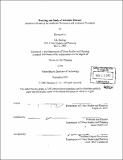Modeling and study of infectious disease : stochastic modeling for antibiotic resistance and treatment strategies
Author(s)
Lo, Monique (Monique Chun-Ying), 1978-
DownloadFull printable version (4.650Mb)
Other Contributors
Massachusetts Institute of Technology. Dept. of Urban Studies and Planning.
Advisor
Eric Klopfer.
Terms of use
Metadata
Show full item recordAbstract
Antibiotic-resistant bacteria pose a serious threat to immuno-compromised individuals in Intensive Care Units (ICU). This study examines several cycling treatments (7,14,30,60,120,240-day cycle) and random fraction treatment (50-50,60-40,80-20,100-0) strategies in ICU and finds that no single strategy will outperform all others. Human, hospital and pathogen conditions such as admission/departure rate, transmission rate, drug application rate, and incoming patients' characteristics influence the selection of the optimal treatment strategy. Random fraction treatment is generally favored when admission/departure rate is large. Cycling treatment is generally favored when admission/departure rate is small. When transmission rates are high, longer cycle period are preferred. When transmission rates are low, random fraction treatments are preferred. For cycling treatments, longer cycle periods is associated with lower drug application rates whereas shorter cycle periods are associated with larger drug application rates.Antibiotic-resistant bacteria pose a serious threat to immuno-compromised individuals in Intensive Care Units (ICU). This study examines several cycling treatments (7,14,30,60,120,240-day cycle) and random fraction treatment (50-50,60-40,80-20,100-0) strategies in ICU and finds that no single strategy will outperform all others. Human, hospital and pathogen conditions such as admission/departure rate, transmission rate, drug application rate, and incoming patients' characteristics influence the selection of the optimal treatment strategy. Random fraction treatment is generally favored when admission/departure rate is large. Cycling treatment is generally favored when admission/departure rate is small. When transmission rates are high, longer cycle period are preferred. When transmission rates are low, random fraction treatments are preferred. For cycling treatments, longer cycle periods is associated with lower drug application rates whereas shorter cycle periods are associated with larger drug application rates.
Description
Thesis (M.C.P.)--Massachusetts Institute of Technology, Dept. of Urban Studies and Planning, 2001. Includes bibliographical references (leaf 46).
Date issued
2001Department
Massachusetts Institute of Technology. Department of Urban Studies and PlanningPublisher
Massachusetts Institute of Technology
Keywords
Urban Studies and Planning.